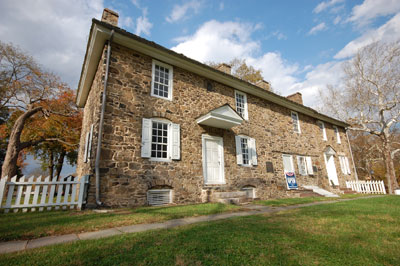Thompson-Neely House & Farmstead
 Ongoing renovations may affect the capacity and operations of this park facility.
Ongoing renovations may affect the capacity and operations of this park facility.
The Thompson-Neely House served as a temporary regimental army hospital during Washington’s winter campaign of 1776/1777. Ill and injured soldiers were brought to this home of the Thompson and Neely families for medical treatment and recovery. A young officer from Virginia named James Monroe, who was seriously injured during the First Battle of Trenton, convalesced here. In 1817, he became the fifth president of the United States. Wounded with Monroe was William Washington, a distant cousin of the commander-in-chief. He too recovered at this location. Captain James Moore of the New York Artillery died here of camp fever on Christmas day and is buried on the property (in what is now the Soldiers’ Graves area), along with other men who died either in the encampment or battle.
On the National Register of Historic Places, The Thompson-Neely House is a fine example of vernacular 18th-century architecture. Its expansion from a low, one-room dwelling to a two-story, multi-roomed farmhouse reflects the growth of colonial Pennsylvania’s agricultural economy and the prosperity enjoyed by those who milled grain into flour for export. Early Scots-Irish settler John Pidcock, who farmed and traded with the Native Americans, settled on this site before 1701. The next owner of the property, Quaker miller John Simpson, constructed the original central section of this house about 1740, as well as a gristmill along Pidcock Creek. At the time of his death in 1747, Simpson was a prosperous farmer with an interest in a sawmill besides his other holdings. His widow, Hannah, married Scots-Irish miller Robert Thompson in 1748, whose farming and milling businesses on the property made him one of the wealthiest men in Solebury Township by 1761.
In 1757, owner Robert Thompson built a two-story addition on the west end (away from the river) of the house. Nine years later, when his daughter Elizabeth married Irish immigrant William Neely, he added a second story above the old first section. The households of both families were under the same roof when 7,400 Continental army troops encamped in the area during December 1776. Robert Thompson enlarged the house once again by constructing the two-story east wing in 1788 to accommodate the Neely’s growing family. Taller ceilings gave this newest portion a higher roofline than the existing structure.
When he died in 1804, Robert Thompson left his large estate to his grandson, Robert Thompson Neely, including the main farmhouse with outbuildings, two mills, a cooper’s shop, and a distillery. Although Robert Thompson Neely continued to expand his family business and real estate holdings, he died in debt in 1848. Succeeding generations of the Neely family continued to own the farmhouse. When the Commonwealth of Pennsylvania acquired it in 1926, the building had been little changed since the early 19th -century.
Once the centerpiece of a working farm and milling complex, the Thompson-Neely House is surrounded by the numerous outbuildings needed for farmlife in the 18th-century, such as the restored smokehouse, chicken coop and privy seen here today. Washington Crossing Historic Park’s own flock of sheep may be visited at the restored barn.

